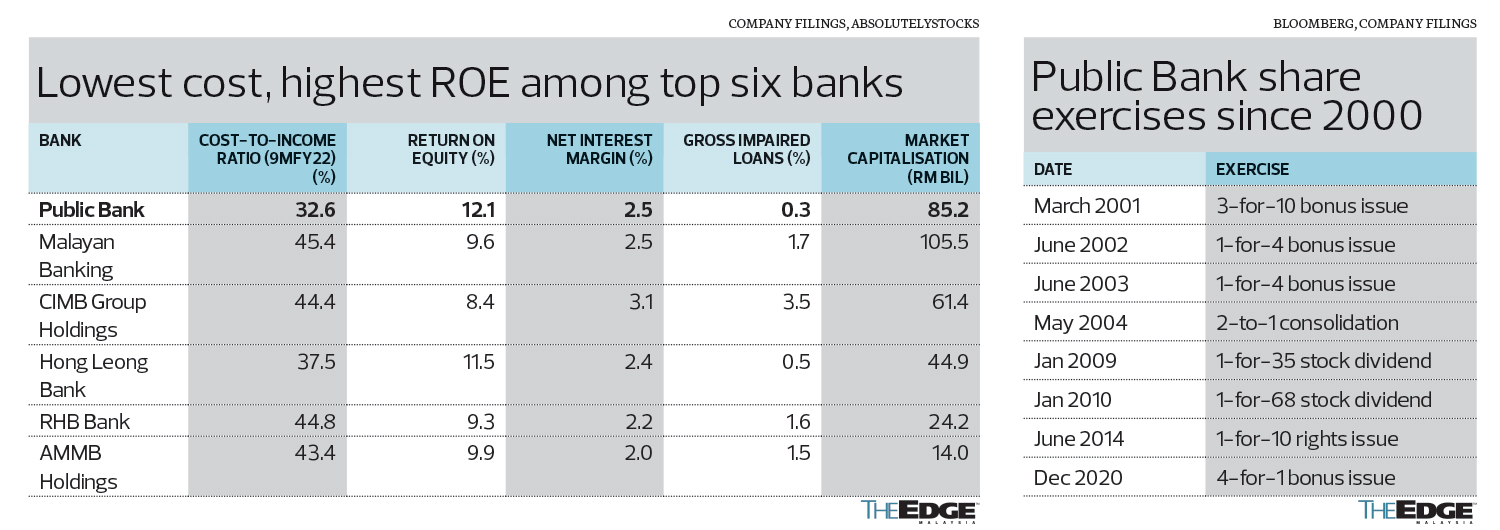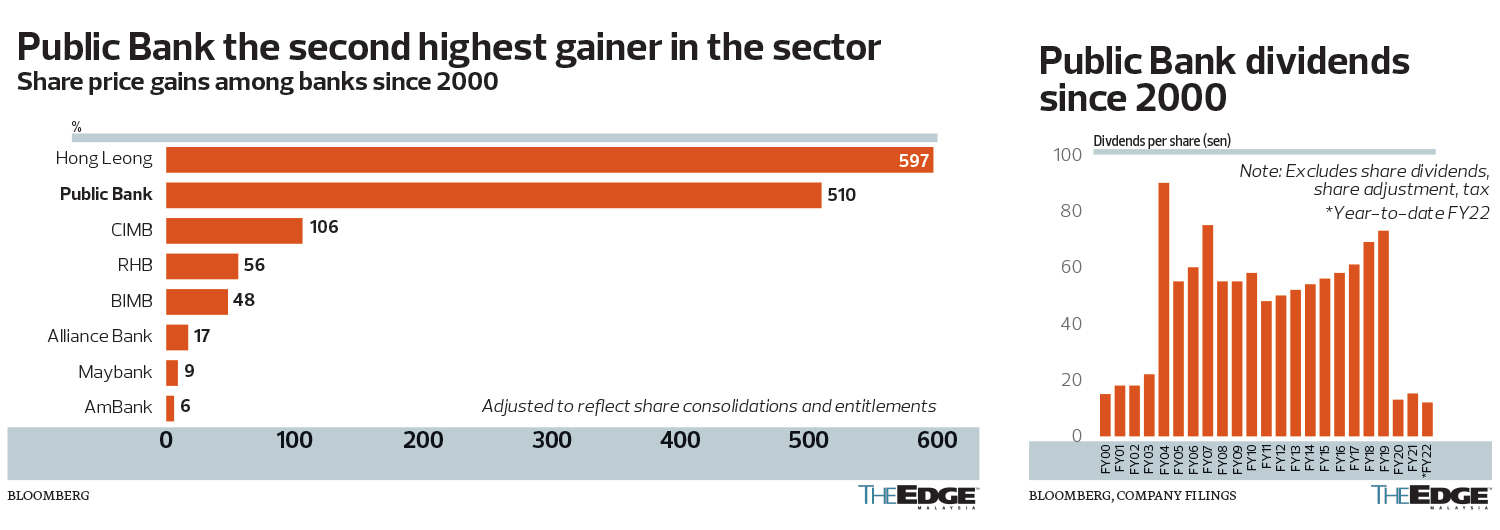
This article first appeared in The Edge Malaysia Weekly on December 19, 2022 - December 25, 2022
PUBLIC Bank Bhd, Malaysia’s second-largest listed banking group by market capitalisation and the third-largest by assets, has been a worthwhile investment for many who stayed on as a shareholder over the years.
Founded by the late Tan Sri Dr Teh Hong Piow, the bank, whose first branch was opened in 1966 in Jalan Gereja, Kuala Lumpur, was listed on Bursa Malaysia in 1967. Since then, it has grown from strength to strength, with a total of 293 domestic branches, 150 overseas branches and a staff force of more than 19,000 people, with a presence in markets such as China, Hong Kong, Cambodia, Vietnam, Laos and Sri Lanka.
Known for its generosity to performing staff, Public Bank is also the gold standard among peers when it comes to cost-efficiency. The cost control was deemed aggressive at times, but has proven beneficial as the bank channelled the savings towards growth and rewarding shareholders.
In terms of market capitalisation, Public Bank was also the fastest growing in the sector, touching a record high of RM98.3 billion in August 2018.
Since the turn of the millennium, Public Bank’s market capitalisation has grown by 830% in 22 years, from just RM9.17 billion to RM85.21 billion as at Dec 13, based on its share price of RM4.39.
Since 2000 — when Public Bank was trading at an adjusted price of 72 sen — the stock has climbed 510%, representing a compound annual growth rate of an impressive 8.56% in the last 22 years. Comparatively, the country’s retirement savings fund, the Employees Provident Fund, provided annual returns of between 4.25% and 6.9% in the same period.
While Public Bank’s performance is second best in the sector (behind Hong Leong Bank Bhd’s 597% gain), it has a penchant for rewarding shareholders with bonus issues, which greatly compounded the gains from the share price appreciation.
An investor who bought into Public Bank at the time of its listing and followed through with just one rights issue in 2014 would have enjoyed capital gains of a whopping 2,998%, even without reinvesting the healthy dividends obtained into the company. This far outperforms the sector’s first runner-up, which still recorded an impressive gain of 754% in the period.
Consider one who invested RM72,000 (adjusted) in 100,000 shares of Public Bank at the start of 2000. The same investor only needed to spend another RM10,600 to fully subscribe to a one-for-10 rights issue entitlement in 2014, for a total investment cost of RM82,600. The value of that investment would have ballooned to RM2.56 million by now.
That means this investor would have enjoyed capital gains that amounted to RM2.48 million — not including dividends — based on the stock’s Tuesday (Dec 13) closing price of RM4.39.
Between 2000 and 2022, Public Bank made four bonus share issuances — in 2001, 2002, 2003 and 2021 — and distributed stock dividends twice — once in 2009 and then in 2010.
Coupled with a two-to-one share consolidation back in 2004 and the rights issue in 2014, the 100,000 shares that the aforementioned investor acquired in 2000 would have multiplied to 583,000 shares today, or an increase of 483%, as opposed to the mere 20% to 176% increase among its peers.
Apart from the capital gains from the increase in share price, cumulative dividends from the past 22 years, compounded by the increase in the number of shares held, amounted to more than RM1 million. Should this amount be reinvested into the company, the investor would certainly have made substantially higher returns.
In total, that original investment would allow that investor to reap in excess of RM3 million in 22 years.
Lowest cost, fastest growing
Indeed, Public Bank’s prudent cost management played a significant role. Among its peers, the bank boasted the lowest cost-to-income ratio of 32.6%, compared with the sector average of 45.8%.
The stock also maintains one of the highest returns on equity at 12.1%. Net interest margins stood at a healthy 2.48%, coupled with the sector’s lowest gross impaired loans of 0.33%, according to data from AbsolutelyStocks.
The strong fundamentals were achieved despite being one of the fastest growing after the 1998 Asian financial crisis (AFC).
Its conservative approach prior to the AFC provided it with a buffer and the ability to loan out to businesses as the economy came out of the crisis, as well as to ride the recovery path.
It went from posting net profit of RM724 million in the financial year ended Dec 31, 2000 (FY2000), to RM5.657 billion in FY2021 — a compound annual growth rate of 10.29%. Total assets rose to RM481.91 billion, more than tenfold from RM45.28 billion in FY2000.
Public Bank’s ability to reward loyal shareholders beats that of many other companies listed on Bursa Malaysia. Indeed, the bank will be a hard act to follow.
Save by subscribing to us for your print and/or digital copy.
P/S: The Edge is also available on Apple's App Store and Android's Google Play.
- Lim Seong Hai Capital opens 17% lower on ACE Market debut
- Top Glove faces rising risks from Chinese rivals, analysts flag after weaker-than-expected 2Q
- Asian stocks slip as growth, tariff worries weigh
- Thailand may yet embark on Southeast Asia's most aggressive rate cuts
- Tabung Haji declares 3.25% profit distribution for FY2024
- Nestlé Malaysia breaks ground for RM250m regional logistics hub in Port Klang
- FedEx cuts full-year results forecast on 'uncertainty' in economy, bad weather
- The New Global Economy: Signs of a US Recession
- UM plans to set up foundation campus at Peking University
- Argentina unions to strike against Milei on April 10


